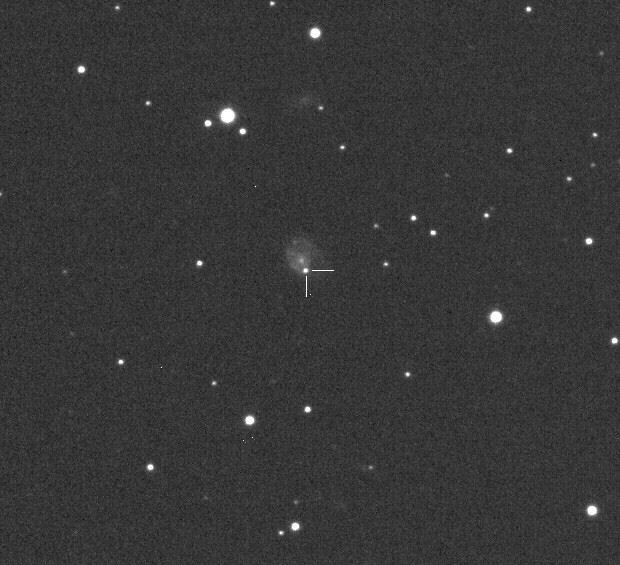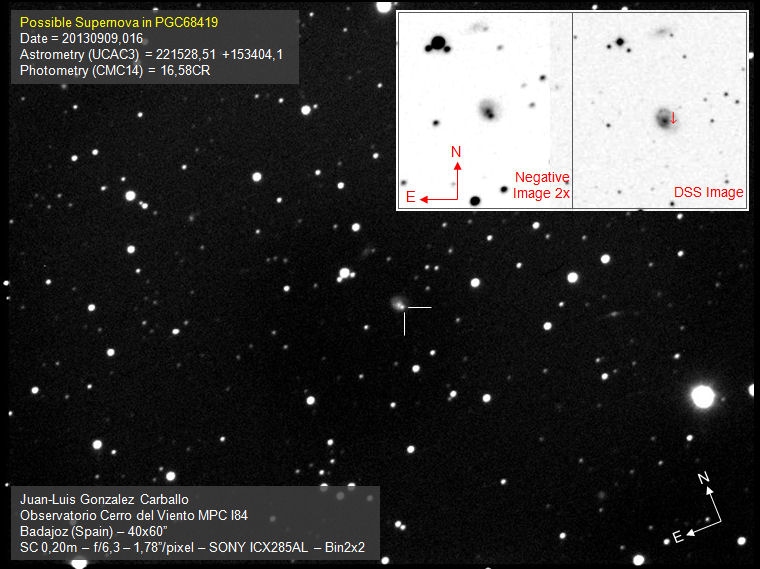SN 2013fj (A.R., 22 15 28.51 Dec. +15 34 04.1), scoperta il 7 settembre 2013 nella galassia pgc 68419 (offset 3W 5S), magnitudine 16.7, tipo: Ia
PSN individuata da Ciabattari, Mazzoni e Juan-Luis Gonzalez Carballo con il telescopio Newton da 50cm dell'Osservatorio di Monte Agliale (Lucca).

Confirmation by Stu Parker (BOSS)

Confirmation by Juan-Luis Gonzalez Carballo
Electronic Telegram No. 3654 Central Bureau for Astronomical Telegrams INTERNATIONAL ASTRONOMICAL UNION CBAT Director: Daniel W. E. Green; Hoffman Lab 209; Harvard University; 20 Oxford St.; Cambridge, MA 02138; U.S.A. e-mail: Questo indirizzo e-mail è protetto dallo spam bot. Abilita Javascript per vederlo. (alternate Questo indirizzo e-mail è protetto dallo spam bot. Abilita Javascript per vederlo. ) URL http://www.cbat.eps.harvard.edu/index.html Prepared using the Tamkin Foundation Computer Network SUPERNOVA 2013fj IN PGC 68419 = PSN J22152851+1534041 F. Ciabattari and E. Mazzoni, Borgo a Mozzano, Italy; and Juan-Luis Gonzalez Carballo, Observatorio Cerro del Viento, Badajoz, Spain, report the discovery of an apparent supernova (mag 16.7) on unfiltered CCD images (limiting magnitude 19.5) obtained on Sept. 7.83 UT with a 0.5-m Newtonian telescope (+ CCD FLI 4710 Proline camera) and on Sept. 9.016 with a 0.2-m Schmidt-Cassegrain f/6.3 telescope. The new object is located at R.A. 22h15m28s.51, Decl. = +15d34'04".1 (equinox 2000.0; astrometry with respect to UCAC-3 stars), which is 3" west and 5" south of the center of the galaxy PGC 68419. Nothing is visible at this position on the digitized plates of the Palomar Sky Survey from 1995 July 29 (F plate, limiting magnitude 20.3) and 1992 Aug. 31 (J plate, limiting magnitude 20.3). The variable was designated PSN J22152851+1534041 when it was posted at the Central Bureau's TOCP webpage and is here designated SN 2013fj based on the spectroscopic confirmation reported below. Additional CCD magnitudes for 2013fj: Sept. 8.933, 16.4 (S. Parker, Canterbury, New Zealand; 43-cm iTelescope T7 reflector; position end figures 28s.46, 03".8); 10.232, 16.8 (J. Brimacombe, Cairns, Australia; remotely using a 51-cm telescope + luminance filter at the New Mexico Skies observatory near Mayhill, NM, USA; position end figures 28s.46, 02".9; image posted at website URL http://www.flickr.com/photos/43846774@N02/9741763049/); 12.803, 17.0 (Gianluca Masi, Francesca Nocentini, and Patrick Schmeer; remotely using a 43-cm telescope at Ceccano, Italy; position end figures 28s.47, 03".3). A. Zanutta, M. Landoni, and A. Bianco, Osservatorio Astronomico di Brera, Istituto Nazionale di Astrofisica (INAF); and S. Spiro, S. Benetti, A. Pastorello, E. Cappellaro, L. Tomasella, P. Ochner, and M. Turatto, Osservatorio Astronomico di Padova, INAF, report that an optical spectrogram (range 470-1000 nm; resolution 1.7 nm) of PSN J22152851+1534041 = SN 2013fj, obtained on Sept. 13.90 UT with the Asiago 1.82-m Copernico Telescope (+ AFOSC, equipped with a new, high-sensitivity holographic grism), shows it to be a type-Ia supernova. Adopting for the host galaxy (CGCG 428-62) a recessional velocity of 10064 km/s (Huchra et al. 1999, A.Ap. Suppl. 121, 287; via NED), a best fit is found with type-Ia supernovae about four days after maximum light. The expansion velocity deduced from the Si II 635.5-nm absorption is about 11000 km/s. The Asiago classification spectra are posted at website URL http://sngroup.oapd.inaf.it; classification was made via GELATO (Harutyunyan et al. 2008, A.Ap. 488, 383) and SNID (Blondin and Tonry 2007, Ap.J. 666, 1024). NOTE: These 'Central Bureau Electronic Telegrams' are sometimes superseded by text appearing later in the printed IAU Circulars. (C) Copyright 2013 CBAT 2013 September 15 (CBET 3654) Daniel W. E. Green




